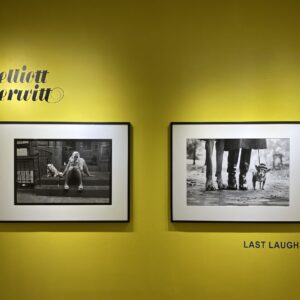 JTF (just the facts): A total of 10 large scale color works, framed in black with no mat and mounted to Plexi, and hung in the entry and main gallery spaces. All of the works are chromogenic prints, made in Turkana, Kenya, in 2009. The prints come in two sizes: 26×39, in editions of 9, and 40×60, in editions of 5. The show consists of 7 works in the smaller size and 3 works in the larger size. (Installation shots at right.)
JTF (just the facts): A total of 10 large scale color works, framed in black with no mat and mounted to Plexi, and hung in the entry and main gallery spaces. All of the works are chromogenic prints, made in Turkana, Kenya, in 2009. The prints come in two sizes: 26×39, in editions of 9, and 40×60, in editions of 5. The show consists of 7 works in the smaller size and 3 works in the larger size. (Installation shots at right.)
 Jehad Nga’s dark portraits of native tribespeople from the drought parched lands of Northern Kenya follow this same trend, adding in a layer of photojournalistic concern. Adults and children in native dress stand alone in the claustrophobic dark, covered in exotic layers of intricate beaded necklaces and luminous patterned cloth, their smoothly shaved heads catching the few shafts of light which intrude on the blackness. The light shines in from the side like a thin spotlight, discovering glancing edges and hidden details: the fragment of a bicycle, the braids of hair, the redness of skin, or the geometries of beads.
Jehad Nga’s dark portraits of native tribespeople from the drought parched lands of Northern Kenya follow this same trend, adding in a layer of photojournalistic concern. Adults and children in native dress stand alone in the claustrophobic dark, covered in exotic layers of intricate beaded necklaces and luminous patterned cloth, their smoothly shaved heads catching the few shafts of light which intrude on the blackness. The light shines in from the side like a thin spotlight, discovering glancing edges and hidden details: the fragment of a bicycle, the braids of hair, the redness of skin, or the geometries of beads. I think these portraits walk a tricky line between powerful and moving imagery and a less savory anthropological examination. While the photographic approach may be modern, there is a whiff of old stereotypes risen again: poor Africans, inspiringly proud and beautiful in their destitution. Nga’s pictures undeniably draw the viewer into the individual narrative of a specific person or family. Having been successfully sucked in, we then ask what these images have to tell us that is new; this is where I was left a bit puzzled. Maybe the answer is that unfortunately things haven’t changed much, and we are still faced with the same societal challenges that have thwarted us for decades. As a result, I left the gallery with mixed feelings: impressed by the strength of the emotion that these images could elicit, but depressed by the conclusion that we are still telling the same African stories.
Through July 16th





It seems whenever the Africans are photographed or a story is told, they have to be impoverished and downtrodden. A symmptom of colonial guilt maybe?
A reaction to this post can be found at Prison Photography here:
http://prisonphotography.wordpress.com/2010/06/12/a-few-thoughts-on-jehad-nga/